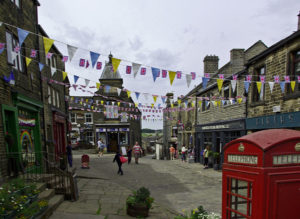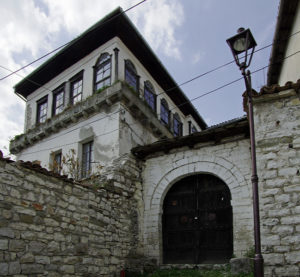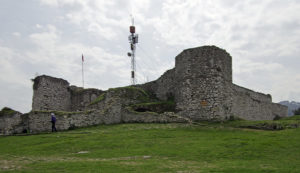Most castles are ruined, not Berat. The walled fortification at the top of the hill is still inhabited and is an exciting place to explore with its network of narrow streets lined with houses which surround the citadel at the highest point. This is where the population lived in unsettled times. It was only later that the Ottoman town grew up under the castle.
Berat Castle towers above the old Ottoman city. Not only was it a defensive site in times of trouble, it also controlled all movement along the valley. Although the area has been fortified since the C4th BC, most of what you see today dates from the C13th and unlike “Gjirokastra Castle,”:http://wasleys.org.uk/eleanor/otherholidays/albania/day_four/four_three/index.html is still inhabited today. Inside the walls is a network of narrow cobbled streets lined with houses, dating from the C18th and C19th. It really does feel as if you are stepping back in time.
The castle is reached by a steep climb from the city and is surrounded by massive C13th walls with watch towers with flights of steps leading to the tops of the walls.
Through the main gateway is a large cobbled courtyard with good views over the surrounding countryside with terraced slopes with olive trees. This leads to another gateway into the castle.
Inside the city is a network of narrow cobble streets lined with houses. This is a fascinating place to explore. The larger houses have a small garden and are surrounded by a high wall with a single gateway. Others open straight onto the street.
Some houses have upper floor extending out over the street to increase the living areas. While most houses are now in a reasonable state of repair, others are in a poor state with external plasterwork flaking off to reveal the construction of the walls.
The main street is lined with stalls selling beautiful hand embroidered table clothes, blouses and other small tourist items. Prices are in Euros and are very reasonable, especially if you are prepared to haggle over the more expensive items.
At the top of the site and surrounded by another wall, is the citadel with a sturdy keep. This was the residence for nobility and commands excellent views along the valley. In times of trouble the rest of the population with their animals, could move into this area for safety. In Ottoman times, the garrison was based here in barracks built along the inside of the walls. Two mosques were built for them, but all that remains is the minaret of the Red Mosque.
The population of Berat was Christian, who had their own churches. Eight still survive. The Christians were allowed to worship during Ottoman times and build churches, but there was an agreement that the church should not be visible from outside. They had to be surrounded by a wall and were not allowed bell towers.
Holy Trinity Church is built on the hillside below the citadel and dates from the C13/14th. It is a small cross shape building which would have been walled. It was preserved during Communist times when the outer walls were removed.
The Church of St George near the far end of the citadel was originally a monastery style church surrounded by stone walls. This was taken over in the 1980s as the government tourist residence. The upper part of the church was demolished and rebuilt to resemble a typical Berat style house. After the fall of Communism, part of the lower floor was used as a church again. The rest of the building is now empty and under the control of the ministry of Culture who are still deciding what to do with the building. In the meantime it continues to deteriorate and part of the roof collapsed in 2016.
The The Cathedral Church of the Assumption of St Mary and the Onufri Museum of Icons are covered by a separate review.
The castle is a fascinating and exciting place to explore. It is definitely worth visiting and spending plenty of time here too.
There are more pictures of Berat Castle “here.”:http://wasleys.org.uk/eleanor/otherholidays/albania/day_six/six_three/index.html










